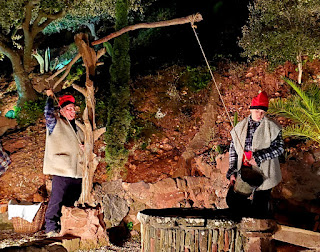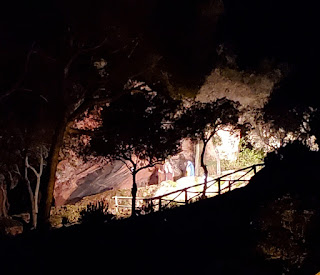Tonight I took part in something that truly make Catalonia unique: a pessebre vivent, or living nativity show. It's not like in the United States, where someone playing the Holy Couple stands in a square built to look like a stable, maybe tending a living child or possibly a doll. No, this is a complete example of medieval Catalan living coupled with the story of the birth of Jesus.
This particular show is the oldest running living nativity in Spain at this time. It started on 24 December, 1962, in the amazing landscape within Corbera de Llobregat. I'll be posting a bunch of pictures, but honestly, until you're in the space, it will seem like a movie set. It's not. It's the actual rock in the village. (You can find more information here: https://pessebrecorbera.cat/pessebre-vivent-de-corbera-de-llobregat/?lang=es )
One of the hardest parts of walking away from the Catholic church after 20 years attending mass weekly was saying good-bye to the rituals, the stories, and the weight of the centuries of experiences. Attending this pessebre vivent put so much emphasis on the things that I loved about being Catholic. When the angel showed himself for the annunciation, I am not ashamed to say that I got choked up. The power of that imagery made my soul ache.
I want to explain something. I started this post by saying that I "took part" in the show. In this particular event, the audience does the moving while the actors (primarily Corbera village people) portray their roles in static places. We were shuttled along from place to place to see the variety of "sets" created for this event. My friend, Isaac (who also played translator and guide), and I wondered what became of this space in the "off-season", and now I want to go back in the summer to see if the space is used as a garden or park, as Isaac suggested.
Something to note: the men with the red caps and wool vests and women with the long, striped skirts are wearing traditional Catalan clothing. Like a lot of the "resurgence communities" similar to the Welsh, Irish, and Scottish of the 19th century, the Catalan language, clothing, and "national pride" came back into being at this time period. The Catalan language, which had fallen out of favor with the upper crust of Spanish society, suddenly had a place at the table, along with many of the traditions that prior to this time period had been considered "country" or "peasant". So, while the actions portrayed by the actors go back hundreds of years, the clothing worn by the men and women only go back about 150 years or so.
There are a lot of pictures because I couldn't winnow them down anymore than I already have. Each on spoke to me on some level, and I wanted to be sure to share them with you. Enjoy!
This particular show is the oldest running living nativity in Spain at this time. It started on 24 December, 1962, in the amazing landscape within Corbera de Llobregat. I'll be posting a bunch of pictures, but honestly, until you're in the space, it will seem like a movie set. It's not. It's the actual rock in the village. (You can find more information here: https://pessebrecorbera.cat/pessebre-vivent-de-corbera-de-llobregat/?lang=es )
One of the hardest parts of walking away from the Catholic church after 20 years attending mass weekly was saying good-bye to the rituals, the stories, and the weight of the centuries of experiences. Attending this pessebre vivent put so much emphasis on the things that I loved about being Catholic. When the angel showed himself for the annunciation, I am not ashamed to say that I got choked up. The power of that imagery made my soul ache.
I want to explain something. I started this post by saying that I "took part" in the show. In this particular event, the audience does the moving while the actors (primarily Corbera village people) portray their roles in static places. We were shuttled along from place to place to see the variety of "sets" created for this event. My friend, Isaac (who also played translator and guide), and I wondered what became of this space in the "off-season", and now I want to go back in the summer to see if the space is used as a garden or park, as Isaac suggested.
Something to note: the men with the red caps and wool vests and women with the long, striped skirts are wearing traditional Catalan clothing. Like a lot of the "resurgence communities" similar to the Welsh, Irish, and Scottish of the 19th century, the Catalan language, clothing, and "national pride" came back into being at this time period. The Catalan language, which had fallen out of favor with the upper crust of Spanish society, suddenly had a place at the table, along with many of the traditions that prior to this time period had been considered "country" or "peasant". So, while the actions portrayed by the actors go back hundreds of years, the clothing worn by the men and women only go back about 150 years or so.
There are a lot of pictures because I couldn't winnow them down anymore than I already have. Each on spoke to me on some level, and I wanted to be sure to share them with you. Enjoy!





















































No comments:
Post a Comment